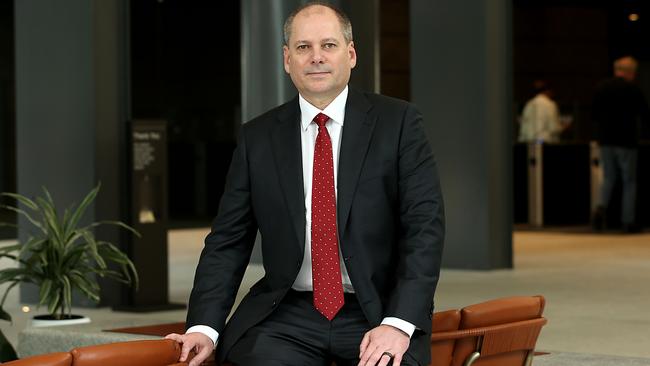Westpac shares hit amid lending margin fears after bank unveils $3.5bn share buyback, doubling of profit
Westpac is testing the market’s faith in its turnaround story, as scepticism grows over key targets set for 2024.

Westpac is testing the market’s faith in its multi-year turnaround story, with investors dumping the stock after a poor margin performance by its key home-lending business and emerging scepticism that the bank will achieve its much-trumpeted $8bn cost base in 2024.
The group reported a 138 per cent increase in net profit to $5.5bn, mainly driven by lower notable items and a $3.8bn turnaround in impairment charges to a $590m benefit.
Volume growth was also restored in the problematic mortgages businesses, and shareholders were rewarded with $5.7bn in announced returns, including a $3.5bn off-market buyback and a 60c final dividend worth $2.2bn. That took the annual payout to $1.18 — up from a Covid-impacted 31c in 2020.
It all counted for nothing, however, as the stock slumped $1.89, or 7.4 per cent, to $23.78, underlining the scale of Westpac’s challenges compared to runaway sector leader Commonwealth Bank, which climbed a further $1.61, or 1.5 per cent, to $106.29.
“The timeline to fix Westpac has just got longer,” Credit Suisse analyst Jarrod Martin said.
“Its revenue-generating ability is less than what we thought last week, as shown by the structural lowering of the margin and the need to assume that costs which are required to fix the business are going to disappear over the next three years.”
Jefferies analyst Brian Johnson said the dramatic fall in Westpac’s share price on a day that CBA stock actually rose said it all.
“CBA doesn’t have to discount in the mortgage market to win market share,” Mr Johnson said.
Westpac chief executive Peter King blamed the selldown on the nine basis-point crunch in the net interest margin from 2.07 per cent in the March half-year to 1.98 per cent in the September half, with the so-called “exit” margin even lower at the end of September.
Mortgage competition, he said, was not only intense, but the bank had been targeting lower-margin but safer owner-occupiers since 2017, instead of investors and those paying interest only.
“And the (margin) pressure hasn’t abated as we head into next year,” Mr King told The Australian.
“There’s been plenty of capital moving into the mortgage market because there’s good returns but it’s very competitive.”
The Westpac chief acknowledged that the bank’s historic focus on margin had switched to regaining some volume momentum.
Previously hit by Covid-related processing difficulties offshore, the Australian mortgage portfolio expanded by 3 per cent, or $14.7bn, over the year, in a “significantly better performance” than 2020.
Last month, however, the prudential regulator began trying to contain runaway growth in the housing market by increasing the banks’ serviceability buffers.
Mr King agreed that further macroprudential intervention was likely unless the market stabilised.
“I think we’re at a point where the regulators rightly are very much focused on affordability of houses and prices outstripping income growth,” he said.
“So it’s right to tap on the brake to slow it down through the buffers, and I think if it doesn’t slow down there’s probably going to be another response coming.
“The affordability metrics that we track are stretched, you have to go back some time to see them as bad as what they are at the moment.”
As previously flagged, the bank’s expenses jumped in the second half, up 9 per cent to $5.7bn excluding notable items.
The biggest components were $140m devoted to investment in financial crime capabilities and systems, and $138m due to less annual leave as a result of Covid-19 restrictions.
As doubts emerged about Westpac’s ability to meet its $8bn annual cost target in the 2024 financial year, Mr King reaffirmed his backing for the aggressive strategy, which is led by divestments and simplification of the operations.
“We did have higher costs this year as a result of some of our (‘fix the bank’) initiatives, so I think analysts would generally like a more precise glide path for costs but we’ve been clear what we’re targeting in 2024,” he said.
The common equity tier one ratio ended the year at 12.3 per cent, comfortably above the prudential regulator’s 10.5 per cent benchmark and leaving room for the buyback.
The CET1 ratio is expected to fall to 11.8 per cent after the buyback and looming asset sales.
The bank also appeared to leave room for topping up the buyback, which fell short of some market expectations.
Westpac said it would still have a strong capital position after the buyback, which together with surplus franking credits and the potential for more asset sales, created flexibility for the board in its continuing consideration of capital management initiatives.
Asked about the outlook for interest rates, Mr King said the market was clearly signalling an imminent upswing.
“Back in March the 3-year swap rate was 35 basis points and it was 140 basis points on Friday, so it’s up a percentage point in a bit over six months,” he said.
“The market is saying we’ve seen the low point of record-low rates and there’s inflation globally which is driving rate expectations.”
As for the trajectory of funding costs, Westpac had the last bit of the low-rate term funding facility offered by the Reserve Bank to draw down.
After that, it would return to wholesale markets and deposit-funding.
This would start to create a little upward pressure on funding costs.





To join the conversation, please log in. Don't have an account? Register
Join the conversation, you are commenting as Logout